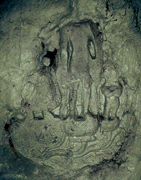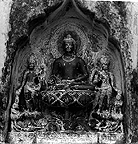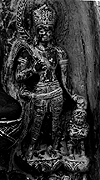The original sculpture would have contained a central figure of a standing Buddha flanked by two bodhisattvas. The bodhisattvas would in turn have been flanked by their attendant or guardian figures. In the Arughat piece, only one of the bodhisattvas and one of the guardian figures have survived. Fortunately the visible guardian can be identified as vajrapurusha. This may suggest that the flanking bodhisattvas were a Vajrapani and Padmapani. While the concept of a Buddha triptych is frequently seen in South Asia, this a particularly lovely example. Of special note is the vine work which supports the five lotuses upon which each of the original figures would have stood. Particularly notice how each of the lotuses sprout from a common large vine which is situated directly below the lotus upon which the central Buddha would have stood.
Although currently missing, a complete sculpture similar to the Arughat triptych was earlier photographed in Patan in the Kathmandu valley (figure 2, right). This 8-9th century image has what appears to be a vine system similar in style to the Arughat fragment. Although the central figure of the Patan triptych is seated, the flanking attendant to the Buddha's far left appears (to the extent that details can be made out) to be quite similar to the corresponding figure in the Arughat triptych. In both the Patan and the Arughat sculptures this figure is a depiction of Vajrapurusha, the personification of Vajrapani's attribute, the thunderbolt (see figure. 3, below). Kramrisch has suggested that the figure's crossed arms denotes a gesture of disciplined submissiveness (vinaya hasta). 1
Although only a fragment, the quality and style of the Arughat piece would suggest a dating similar to that assigned to the Patan triptych -- that is somewhere around the 9th century. The dating and quality of the piece would further suggest it is the product of Newar artisans. Whether produced locally or transported from the Kathmandu valley, this fragment would indicate that at an early date Newar culture had reached as far west as Arughat. While evidence of Newar activity and a Licchavi presence have been reported as far west as Gorkha - even farther to the west than Arughat - this fragment provides further testimony to the expansion of Newar culture of the Licchavi period.2
Send a letter commenting on this article.


